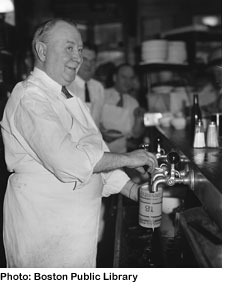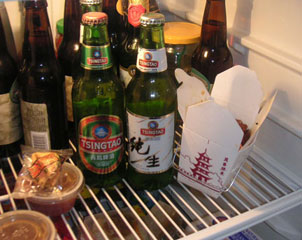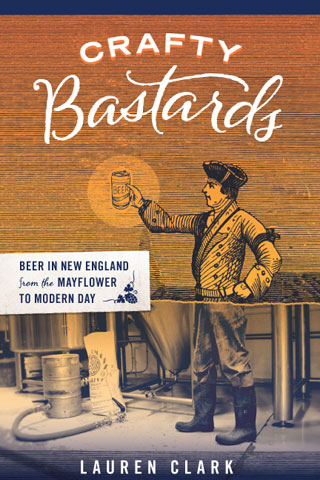February 13th, 2008
 I have never met Walt Mates, but I plan to someday. Walt tends bar at Bistro La Belle in Midway, Kentucky. He is a fan of drinkboston, and I’d be lying if I said that didn’t influence my admiration of him. That and the fact that he stumbled upon this blog while researching the Saratoga cocktail. And the fact that his late father is from Somerville.
I have never met Walt Mates, but I plan to someday. Walt tends bar at Bistro La Belle in Midway, Kentucky. He is a fan of drinkboston, and I’d be lying if I said that didn’t influence my admiration of him. That and the fact that he stumbled upon this blog while researching the Saratoga cocktail. And the fact that his late father is from Somerville.
But what I really like about Walt is that he started his bartending career in midlife, after the bookstore he owned closed down a couple of years ago. Instead of being bitter about the transition, he found that he loves his new line of work. “I am very fortunate and thankful to have a boss who backs me 100 percent in offering carefully crafted classic cocktails using all fresh ingredients,” he says. And he likes his customers and co-workers, too! But recently, Walt emailed me to confide that he’s been feeling a bit peeved lately. He has been grappling with an issue that I think all bartenders deal with. He refers to it as “status anxiety.” Here’s what he wrote:
“I have already told you that what I have enjoyed the most about drinkboston are the interviews with and profiles of Boston’s best bartenders. What has struck me about so many of these individuals is that they seem to be Jacks and Jills of many trades and possess really varied and truly interesting backgrounds.
“I have been tending bar for a year and a half now, specializing in classic cocktails. Guests of the restaurant and my boss have been pleased and impressed with the drinks I prepare. And I can honestly say that I love my job. I treat and consider it as a craft and a profession. But I am beginning to experience a little status anxiety.
“Some people here in town who respected and eagerly interacted with me as a bookstore owner now treat me as a service worker. And while I realize that only shows how puny THEY are, at times I feel like shouting, ‘I am more than just a bartender!’ For heaven’s sake, your friend Misty is a Harvard Divinity School grad! As much as I love the job, I have been wondering whether it is ‘enough’ for me personally and professionally.
“To boil it down, I was wondering whether some of the bartenders you know, who have done and accomplished many different things over the course of their lives, have expressed this same restlessness.”
“Let’s put your question on the blog,” I said to Walt, and he agreed. So, bartenders, I’d love to hear your thoughts. Do some customers look down on you because you are a “mere” service worker? Do you ever feel the need to mention that you have other pursuits beyond mixing and serving drinks? Or do you simply dismiss as misguided anyone who believes that it’s impossible to find professional fulfillment behind a bar? Weigh in by leaving a comment below, or, if you’d rather not, email your words of wisdom to me and I’ll add them to the mix. Thanks!
Permalink | 17 Comments | Filed under Bartenders | Tags: Bartenders, career choice, respect, status
February 9th, 2008

By MC Slim JB
With this post, drinkboston introduces a new guest contributor, MC Slim JB. MC is a Boston-based writer whose honest, sharp restaurant reviews and food/drinks features have appeared in Boston Magazine, the Boston Phoenix, stuff@night, and the Weekly Dig. MC is also a frequent contributor to the restaurant review website Chowhound.
As a cocktail lover, I often sing the praises of my favorite bartenders’ technical chops: their ability to assemble well-balanced cocktails with speed and precision from the best and freshest ingredients, and to serve them with the right garnish, in the right glass, at the right temperature. But those skills are learnable. With enough training and practice, just about anybody can do those things well. A less transferable skill is the hospitality aspect of bartending, the person behind the stick’s ability to make each customer feel welcome, comfortable and well cared for.
I tried to think of a few small things that my favorite bartenders do that make me happy about my experience in their bars, and — having gotten accustomed to this kind of hospitality — that make me unhappy in places that don’t do them. Here are a few:
1. Acknowledge my presence with a word, a look or a nod when I first walk up to the bar. This way I know, even when it’s crazy-busy, that you’ll eventually get to me. That tiny bit of reassurance that I haven’t been lost in the crowd or deliberately ignored makes a big first impression.
2. Take the time, if you can spare it, to share my love of fine cocktails by talking with me about them. I love to hear more about the drink you’ve made me, the spirits and other ingredients that go into it, interesting variations on it, the lore and history surrounding it, who else makes a great one in town, suggestions for other cocktails you think I might like. I want my bartenders to share my fascination with cocktails and to be scholarly and passionate about their work, not just mechanics on an assembly line. (And for my friends who don’t care about that stuff, make and serve their drinks without fanfare or foofaraw.)
3. If I’m by myself, facilitate some interaction with other patrons. Share a story, talk up the game on the TV, make an introduction. Drinking isn’t much fun as a solitary sport, but not everyone is at ease striking up conversations with strangers, especially when traveling or in an unfamiliar venue. The bartender is in a unique position to bridge those social gaps, to help solo patrons feel a little less lonely and, incidentally, to offload some of the burden of entertaining them and so better tend to other customers.
4. When it’s time for me to go, give me an accurate check and bring my change or credit slip promptly. This is my last impression of your service before I leave a tip. It’s a good step to execute crisply.
There are hundreds of other little things that get bartenders onto my “awesome” list. Although thousands of people pass through his bar, Rob at the B-Side manages to remember my usual, even when I haven’t been by in months. No matter how busy it is at the bar at No. 9 Park, John always shakes my rye flip for five minutes. (Try this with a full shaker sometime to see how much work it is.) At Sasso, Casey invariably finds a way to get a conversation going between me and the rest of the bar. Every time I go by Green Street, Dylan has some innovative new concoction he’s itching to pour for me while expounding on its backstory. Sure, these folks are all great cocktail technicians, but it’s the way they make me feel like an important customer that inspires my loyalty. That’s what makes throngs of devotees follow them wherever they work. Hospitality skills are what separate the merely competent bartenders from the great ones.
Permalink | 9 Comments | Filed under Bartenders | Tags: MC Slim JB
February 6th, 2008

By Scott N. Howe
Chinese New Year is almost here. For some of us, that means a trip to Chinatown to check out the pageants and dodge the firecrackers. For the rest of us, that means a better-than-average excuse to order some Chinese take-out and throw down a few cold bottles of Tsingtao lager.
As the retro beer trend has taught us, context can trump taste. Grill me a hot dog at a backyard barbeque, and I want a PBR. Order me some greasy fried rice and a carton of crab rangoons at 2:00 a.m. after the bars have closed, and pour me a Tsingtao.
The nice thing about Tsingtao is that it gives you context and taste. It is the number-one imported beer from China, and you can find it in virtually every Chinese restaurant — and for good reason. As the nice folks at Tsingtao assert, “Tsingtao complements spicy or flavorful Asian cuisine.” They’re right. The beer is light, but not bland, malty, but not bready. From my experience, it goes great with high-end, authentically prepared Chinese cuisine, low-end, indifferently prepared take-out, and everything in between.
Crisp, tasty and hard to pronounce, it’s the beer you should be drinking as you celebrate 2008 — the Year of the Rat.
Permalink | 7 Comments | Filed under Beer |
February 3rd, 2008

OK, that title’s a bit of an exaggeration. But it’s based on fact. The Beehive, which bills itself as a “neighborhood café des artistes,” is a new and very popular nightclub in the South End. Like all new and very popular nightclubs, it has its detractors: People who had to wait in a long line. People who think the food and cocktails are overpriced. People who were treated rudely by the staff. “Obnoxious crowd, unnecessarily obnoxious bouncers, mediocre music and food, cool look downstairs,” begins one critique on yelp.com. I have heard some people say that the owners are jerks. Other people I know have gone expecting the bar staff to be knowledgeable about vintage cocktails and have been sorely disappointed. Most of my acquaintances who have tried the food have been unimpressed at best.
But most people, even detractors, agree on one thing: the Beehive is a cool-looking place. (On yelp.com, by the way, the Beehive currently gets three-and-a-half out of five stars based on 90 reviews. Not bad.) The first time I visited, I thought to myself, ‘They did it. Someone created a really original hangout in Boston that’s not a rock club or a dance club or a trying-too-hard-to-be-chic martini bar.’ The cavernous brick interior, the red velvet drapery, the intimate little cabaret tables, the vintage chandeliers and, especially, the bold and witty contemporary art — all make for an impressive space. And the clientele illustrates the apparently revolutionary truth that people over 30 go out at night.
I have only been to the Beehive a few times, always on off-nights (i.e. not Thursday through Saturday), so I’ve never had to wait in line. Is the place worth waiting in line for? For 10 minutes, maybe. For an hour? I don’t think anyplace is worth waiting in line for that long. The Beehive Julep (rum, Creole Shrubb liqueur and lime juice) I had on my first visit was sloppily thrown together and nothing to write home about. The champagne and Cointreau cocktails I had on another visit were tasty (and hard to screw up, admittedly). The server who brought those champagne cocktails to me was an absolute doll. I love the fact that for $10 a ticket, the Beehive recently hosted a show called Titler’s Oddville — a strange, naughty, highly entertaining vaudeville revue. I didn’t love the fact that the stage was barely visible because the audience was made to stand.
So, the Beehive is far from perfect. But they’re doing something different. For that reason it’s hard for me not to root for the place and make plans to go back.
Permalink | 4 Comments | Filed under Boston bars |
January 29th, 2008
 Canadian Club, that once-respected whiskey that got pushed out of drinkers’ consciousness by the vodka tidal wave on one hand and the emergence of boutique ryes and bourbons on the other, is trying to make a comeback. The brand, now owned by Jim Beam, is running a catchy ad campaign in magazines like Esquire and GQ. Naturally, I wanted to include here an example of one of the ads, but I couldn’t for reasons I’ll explain in a minute.
Canadian Club, that once-respected whiskey that got pushed out of drinkers’ consciousness by the vodka tidal wave on one hand and the emergence of boutique ryes and bourbons on the other, is trying to make a comeback. The brand, now owned by Jim Beam, is running a catchy ad campaign in magazines like Esquire and GQ. Naturally, I wanted to include here an example of one of the ads, but I couldn’t for reasons I’ll explain in a minute.
The ads are fun. They play on the same sensibility that fueled the comeback of old-school beer brands like PBR, Schlitz and Narragansett. Their images, which look like faded, creased photos from the ’60s and ’70s, show men of a bygone era doing “man” things like fishing, playing in a band and partying with babes in a shag-carpeted rec room. Oh, and drinking C.C. in heavy-bottomed rocks glasses, of course. The ad with the guys fishing reads, “Your dad was not a metrosexual. He didn’t do pilates. Moisturize. Or drink pink cocktails. Your dad drank whiskey cocktails. Made with Canadian Club. Served in a rocks glass. They tasted good. They were effortless. Damn right your dad drank it.”
Wow. Is that a bitch slap. To the modern man. Or what?
The thing I love about these ads, besides their authentically retro look and their towel-snapping text, is that they are nothing like other whiskey ads, whose warmly lit still-life-with-bottle aesthetic evokes heritage and taste. Yawn. The C.C. ads are saying, ‘Hey, remember when drinking whiskey wasn’t about drinking whiskey but about what was happening while you were drinking whiskey?’ Yeah!
Another reason these ads resonated with me is that, by coincidence, I recently tasted C.C. for the first time in ages. A couple we know had a small gathering at their house. There was nary a mixology book in sight. Just a big stone fireplace and a magically replenishing pitcher of Manhattans. Sitting in an armchair sipping my drink, I asked my host, “What kind of whiskey did you use?” With a little smirk and a shrug, he said, “Canadian Club,” and awaited the commentary of the Booze Snobs. Scott and I looked at each other, then back at our host. “It’s good!” Then we all went back to discussing the presidential election.
Unfortunately, my budding appreciation for C.C. soured when the Jim Beam legal department reared its ugly head. You see, I emailed the C.C. brand manager to ask for permission to use an ad image from the website for this post. Upon his request, I even described the post’s content, saying that it would be a commentary on the new ad campaign and favorable toward the product itself. But then things got stupid. “Sounds great!” he replied. “I just spoke with my legal team. They asked that we get to see the article before it’s run. Will this be ok with you? I will be able to have this approved within a matter of hours once you submit.”
Once I submit? Oh, that’s rich. Let me get this straight, buddy. I’m writing an article about your whiskey brand on a website frequented by the exact demographic you’re targeting, and your lawyers have to approve my use of your ad as an illustration? What, free advertising isn’t enough for you people? You have to have editorial control, too?
Yeah, I know. Maybe I should’ve behaved like every other blogger in the universe and simply grabbed a jpeg from the Canadian Club site without asking first. But my dad taught me to be conscientious. And he drinks Dewar’s.
Permalink | 18 Comments | Filed under Booze in the news, Whiskey |
 I have never met Walt Mates, but I plan to someday. Walt tends bar at Bistro La Belle in Midway, Kentucky. He is a fan of drinkboston, and I’d be lying if I said that didn’t influence my admiration of him. That and the fact that he stumbled upon this blog while researching the Saratoga cocktail. And the fact that his late father is from Somerville.
I have never met Walt Mates, but I plan to someday. Walt tends bar at Bistro La Belle in Midway, Kentucky. He is a fan of drinkboston, and I’d be lying if I said that didn’t influence my admiration of him. That and the fact that he stumbled upon this blog while researching the Saratoga cocktail. And the fact that his late father is from Somerville.



